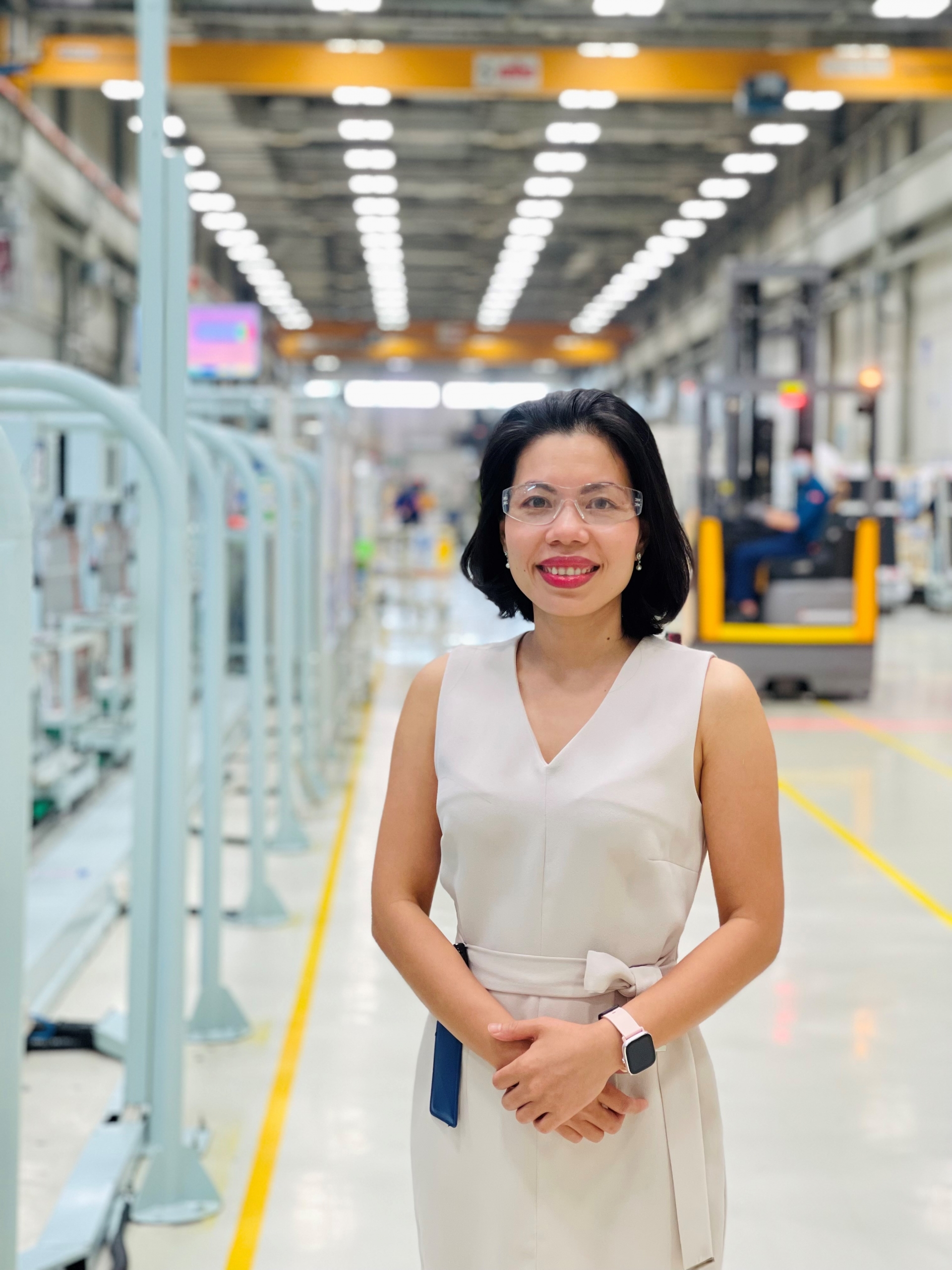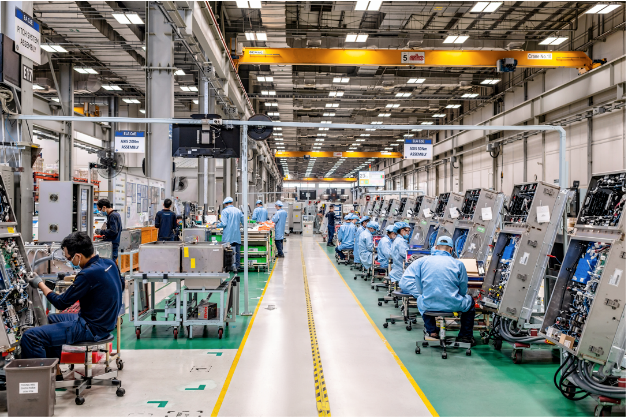GE’s journey to improve Vietnamese suppliers’ capacity
For five years, Dong Thi Thuy Duong has been the sourcing growth leader for Southeast Asia region at GE Renewabler Energy’s Haiphong facility, which is one of GE’S seven brilliant factories and specialised in manufacturing electrical components, machinery, and equipment for wind turbines and other energy systems.
Currently, local content makes up almost 30 per cent of the facility’s suppliers, 44 of whom are manufacturing companies. These impressive figures are the result of a 10-year-work by Duong’s team and her predecessors indicating GE’s relentless efforts to export heavy industrial products that are made in Vietnam across the globe.
 |
| Dong Thi Thuy Duong, sourcing growth leader - Southeast Asia at GE's Haiphong facility. Photo taken before the pandemic |
In her position, Duong has had the opportunity to work with thousands of Vietnamese suppliers.
“There is a huge potential for Vietnamese businesses, but they need leading businesses serving as bridges to integrate into the global supply chain, and GE is one of those bridges,” she said.
Duong and her team’s daily tasks include developing a database of potential suppliers for GE. Upon request, she and her team will search the database and select suitable suppliers for the production. This process seems simple but involves carefully reconciling a multitude of complicated factors.
“The first step is to filter out potential partners from the huge database we have built, then we conduct a series of surveys to arrive at a single choice,” Duong explained. “It doesn’t end there, however. The candidate is subjected to yet another comprehensive evaluation including their technical capacity, machinery, labor safety, environmental standards, respect for human rights, and competitive cost. If they meet all requirements, GE will sign a contract for trial production. Even after all these evaluation rounds, GE’s engineering team will continue to monitor everything until the first product is released.”
“The entire process takes six months to a year or even up to two years for more complex products. A new manufacturer usually takes 2-3 years to fully adjust to the intensity and the working processes of GE. Many suppliers have told me that if they can meet GE’s requirements, they are confident in meeting the requirements of any other customer,” Duong added.
The benefits on offer for suppliers is commensurate with the strict requirements. Once they become a GE partner, they will have access to exclusive support and resources to take their brand and products to an entire new level. They will become a part of GE’s global supply chain.
Since 2008, the GE Haiphong facility has been generating export revenues worth of $2 billion. With about 30 per cent of local suppliers, the number of products that are made in Vietnam reaching global markets is certainly not small.
 |
| Inside GE’s Haiphong facility. Photo taken before the pandemic |
“As someone who directly works with local suppliers, I am extremely proud of how far they have come. One day, the world’s largest wind turbines will run with Vietnamese-made components. How wonderful will that be? Whenever we meet the GE team from around the world to evaluate products, seeing the Vietnamese flag makes me proud,” Duong shared.
Prioritising Vietnamese suppliers is one of GE’s localisation strategy and extends beyond simply using local products at facilities like GE Haiphong but also includes support programmes that GE has been diligently implementing for many years.
“Many suppliers fall short of our strict requirements the first time they apply. However, that is not the end of the story. Instead of excluding them, we classify them as potential suppliers to be supported by communicating and assessing their defects, helping to improve their production processes, product quality, and suggesting future directions to enter the GE supply chain. When they feel ready, they can return to GE where we wait for them with open arms.”
Duong further added: “This open and supportive strategy has encouraged Vietnamese businesses to contact GE in growing numbers. Besides, we still conduct exchanges with potential and active businesses despite no prior request. Currently, GE is building and analysing data to better understand Vietnam’s supply chain.”
GE has been increasing the localisation rate in supply chain through training programmes for promising local partners. One of them is the Vietnam Supplier Development Pilot Programme that started in 2018. This programme is a collaboration between the Ministry of Industry and Trade and the International Finance Corporation. GE is one of eight multinationals corporations participating in the programme as advisors. Currently, it is at the end of its second phase and has gradually recorded many positive results.
GE’s activities continue to create practical changes. At the Haiphong facility alone, suppliers have made remarkable progress, according to Duong.
“For example, it used to be difficult to find a supplier for products over 1m in diameter. But in the last five years, many contractors have managed to meet and even surpass this target. Some contractors are now capable of producing products up to 4m in diameter, which can be used by global factories,” said Duong.
All these ultimately show that Vietnamese businesses are ready for the new stage and have the capacity of producing high-class products for large international markets. And GE stands ready to accompany Vietnamese suppliers on this journey.
Pham Hong Son, president of GE Vietnam, asserted that one of the company’s main achievements is exporting locally produced, heavy industrial products to the global market.
The doors of GE across the globe are open for suppliers looking to enter the global supply chain and become factories of the world. All they need is the confidence and tenacity to overcome their limitations.
“GE’s suppliers have come a long way during the five years I have been in this position. Along with the government incentives for local products, the future for Vietnamese suppliers is shining brightly. However, they need to overcome several shortcomings that have been characteristic of the local industry for a long time,” Duong shared.
One of these limitations is the outmoded perceptions and thinking of business leaders.
“I often tell business leaders to see GE’s high requirements as an opportunity to grow. I worked with a mechanical company in Hanoi which went as far as the prototype stage. However, when GE asked to fix a machining error, they wanted to stop because they were afraid, they could not fulfil the requirements. It was such an unfortunate. Therefore, suppliers must make all efforts and accept the challenges to move forward,” Duong said.
She added that local businesses struggle the most often with meeting the criteria on stable product quality and consistency to ensure safety and lean operations. High prices are also a big barrier.
“While adopting a can-do attitude, local businesses should invest more in people, especially improving engineers’ language skills, capacity, among others. They should also look into acquiring international certificates, for instance in risk management APQP4Wind for the wind industry, CE, UL, CSA, and others to elevate their business. I believe with the support of the government, local suppliers will be able to reach a new stage, and GE is ready to support them in reaching out to the world,” Duong said.
What the stars mean:
★ Poor ★ ★ Promising ★★★ Good ★★★★ Very good ★★★★★ Exceptional
Related Contents
Latest News
More News
- Addressing Vietnam's energy challenges with aeroderivative gas turbines (February 28, 2023 | 09:33)
- How to sprint ahead in 2023’s worldwide energy priorities (February 08, 2023 | 13:55)
- Boosting Vietnam's grid stability through gas turbine technology (November 22, 2022 | 20:02)
- Healthcare trio collaborates to provide thousands of free breast scans (October 27, 2022 | 17:19)
- GE Healthcare's vision for AI-backed radiology (September 29, 2022 | 11:53)
- GE brand trio to shape the future of key industries (July 19, 2022 | 15:35)
- GE unveiling brand names and defining future (July 19, 2022 | 15:16)
- GE: the shortest route towards sustainability (July 18, 2022 | 08:00)
- Be proactive in an uncertain world (May 20, 2022 | 11:40)
- GE secures first 9HA combined cycle power plant order in Vietnam (May 16, 2022 | 17:06)

 Tag:
Tag:





















 Mobile Version
Mobile Version